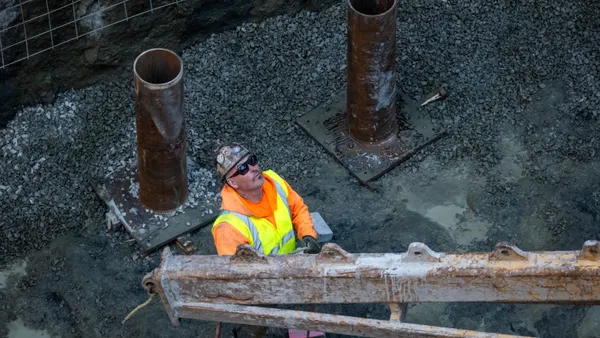Dive Brief:
- The value of total construction starts in January fell 2% from December to a seasonally adjusted rate of $725.9 billion, according to Dodge Data & Analytics, chipping away at December's upwardly revised gain of 12%. On a 12-month moving average, January starts increased 2% from the period ending January 2017 and fell 7% when comparing January 2018 to January 2017.
- An 18% drop in non-building starts – likely more of a correction after a 45% December increase for that category – drove last month's overall decline. January also saw a 15% decrease in overall starts for public works projects; more specifically, a 34% plunge in highway and bridge construction. However, buoyed by the groundbreaking for the new $2 billion Las Vegas Raiders stadium, nonresidential starts increased 1% while a multifamily comeback pushed residential starts up 7%.
- The January Dodge Index was 154, down from a revised December reading of 156. According to Robert Murray, Dodge's chief economist, January's slide was not so much a decline as it was a sign of the industry's "decelerating expansion." Murray also said institutional starts should continue 2017's brisk pace, but that the industry overall could be impacted by increases in material prices and a lack of skilled labor. In addition, while the tax reform package could help the construction sector, positive gains from a public works program like the one the Trump administration has proposed could be constrained by a mounting budget deficit.
Dive Insight:
Despite a promise that infrastructure would be a priority in the first 100 days of President Donald Trump's administration, it was only this month that the White House released a firm proposal. Meanwhile, analysts, as well as the construction industry as a whole, have been trying to project when the cash and other benefits from the infrastructure initiative will start to flow. So, what started out as great enthusiasm from many quarters has evolved into more of a wait-and-see approach. How long the wait will be depends now on what kind of agreement the White House and Congress can hammer out.
One likely hurdle that will arise in the infrastructure discussion will be how the federal government will fund its share. The president's original plan called for a direct federal spend of $200 billion that he said would spur $800 billion in additional outlays by state and local governments, as well as by private investors. However, he recently stated that the federal government's share could be more and upped the potential value of the entire program to $1.5 trillion.
As far as financing mechanisms go, the conversation has mostly centered around an increase in the federal gas tax, which is the main source of revenue for the Highway Trust Fund (HTF). The HTF allocates money to the states for their infrastructure projects but is running dry because the gas tax hasn't seen an increase since 1993. Lawmakers from both sides of the aisle have made their opposition to a gas-tax hike clear, but the administration has expressed initial support for a 25-cents-per-gallon increase.













